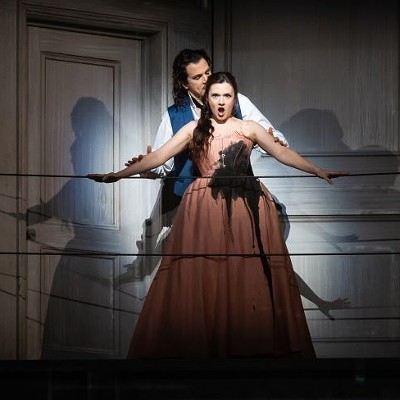Sometimes great expectations are realized. Not as often as we’d like, perhaps, but often enough to keep hope alive. Recently I went to see “Paint the Revolution: Mexican Modernism, 1910-1950” at the Museum of Fine Arts, Houston, expecting to be blown away by it, and I was. Tropical Storm Cindy, blowing up from the south that day, fizzled for Houston, but this art from our stormy southern neighbor most certainly does not.
“Paint the Revolution” comes to Houston by way of the Philadelphia Museum of Art and Museo del Palacio de Bellas Artes in Mexico City. It includes 175 paintings, sculptures, drawings and prints, plus one film. Since murals of monumental size, painted directly on walls, are among the most important aspects of Mexican art of the period, but clearly cannot travel, the exhibition also includes two innovative (and mostly effective) video immersions of the mural-viewing experience.
With “Paint the Revolution,” the tingle — that thrill down the spine that says you’re seeing something special — started at the beginning and continued right through to the end. Immediately inside the first gallery, Francisco Goitia’s Zacatecas Landscape with Hanged Men I of about 1914, a Goya-worthy image of skeletal corpses swinging from trees in a desiccated landscape of revolutionary desolation, set against the shocking beauty of a powder-blue sky, is stunning. The stick-figure abstraction of the corpses is horrifying and exquisite.
And in the last gallery, with The Devil in the Church by David Siqueiros from 1947 arching above me, I became just another member of the mass of humanity raising arms in supplication to a demon far above, supreme in a crumbling cathedral-world likely to crush all as it collapses.
Time after time it is telling details, closely observed and faithfully reported, that pack the wallop, whether of shock or of subtle comfort.
In José Clemente Orozco’s The Rape (1926-28), one barefoot rapist, shown from behind, absurdly tucks in his shirttail as he pulls up his pants, while his co-rapist continues his unspeakable violence on their struggling victim. The details are chilling and crucial: the pistol and military caps on the floor, the painting knocked askew on the wall, the woman’s strapped, high-heeled shoes. It’s soul-deadening — an image that crystalizes the inhumanity of some humans toward others, on an individual and a much larger scale. Did Orozco actually see the rape, you wonder in shock?
Okay, this is sounding a little bleak, but let’s face it, a lot of what happens to people in the world is just that, and Mexico has seen it often. And Mexican artists haven’t been shy in depicting it. There’s a reason that “Revolution” is in the title of the show.
But not all is death and destruction. On the comfort side, note the wisp of mustache in Siqueiros’s early self-portrait of 1921, and the graceful nude on the liquor bottle label of Diego Rivera’s 1918 Cézannesque Still Life with a Bottle of Anise.
And in yet another piece, this one by Antonio Ruiz from 1938 titled Bicycle Race (he’s one of the many revelations for me in the show), similarly compelling details — a sleeping dog, a grazing goat, a discarded bottle and a woman’s shoes again, in the lower left — support not horror but the central intensity of bicyclers focused on victory, as bystanders, adoring if somewhat distracted by life, cheer them on — a scene that could have been painted by Henri Rousseau, except for the exotic Mexican wildness at its core.
I mention Cézanne and Rousseau not by accident, because, as the exhibition title also tells us, “Modernism” in the art historical, as well as cultural, sense is another central focus of the show, but modernism transformed through an encounter with the tumult and clashing civilizations of Mexico. Rivera’s Portrait of Luis Guzmán is a reminder that the artist was as much a Parisian cubist as Picasso and Braque, but the serape over Guzmán’s shoulder claims both artist and subject for Mexico.

Frida Kahlo, Moses, 1945.
Photo courtesy of Private collection, Houston. © 2017 Banco de México Diego Rivera Frida Kahlo Museums Trust, Mexico D.F. / Artists Rights Society (ARS), New York
This Mexicanidad — finding and embracing essential Mexican-ness in the midst of revolution and the modern world — is a fundamental element of all the works in the show, as it was of the cultural and intellectual life of Mexico throughout the decades covered. No matter how modern, no matter how revolutionary, these works are inescapably Mexican and that’s the source of their force — a force long felt far beyond the borders of Mexico, and especially here in Texas.
With talk of walls, some try to forget that Texas was once part of Mexico, and that Mexican history and art are in a real way our own — even for the half of us who do not have Mexican ancestry. In some ways Texans of earlier times were more open to that idea than many are today. Way back in 1932, a major touring exhibition of 400 “living, vibrant and forceful” (to quote a newspaper of the time) works of Mexican art and craft came to MFAH. Inevitably that show included many of the same artists who are back with us now, though they were contemporary artists then. Roberto Montenegro, whose Maya Women is a star of the current show, came here himself that same year for his own one-artist show.
Houstonians, including our artists, took note, but they had already been learning from — even going to — Mexico for decades. Emma Richardson Cherry, the founder of modern art in Houston, made her tour in 1905, sending back her images along with her postcards. Dozens more followed her lead over the next 50 years — most notably, perhaps, Dorothy Hood, who spent 20 years in Mexico, from 1940 to 1960.
For them and for other Texas artists of the time, one of the many things they learned was the vital importance of distilling that essence of place in order for their art to have uniqueness and power: Texan-idad, shall we call it (if you’ll forgive me for mangling both languages)? You might want to take a short trip north to the Pearl Fincher Museum in Spring in the next couple of months for a look at some of the results of that concept in the exhibition “Dignity in Labor: Texas Regionalism from the Bobbie and John L. Nau Collection,” curated by Alika Herreshoff.
Unfortunately, no Houston artists are included, but there are compelling works by other Texas artists working in the 1930s and 1940s. And yes, these Texans were looking to Thomas Hart Benton and his followers in a quest to find a uniquely American modernism, but the Mexicans loomed over them all. The Texas paintings may look a little tame by comparison — perhaps because, even at its most challenging during the depths of the Great Depression, life in Texas was tamer than in Mexico — but they are artistic cousins.
But Houston artists in Mexico will be the subject of an exhibition next year. For this year, with “Paint the Revolution,” we have Mexican artists in Houston, disturbingly, beautifully, gloriously, and art exhibition hope is renewed once again.
Paint the Revolution: Mexican Modernism, 1910-1950
Continues through October 1 at the Museum of Fine Arts, Houston, 1001 Bissonnet, 713-639-7300, mfah.org.
Dignity in Labor: Texas Regionalism from the Bobbie and John L. Nau Collection
Continues through September 9 at the Pearl Fincher Museum of Fine Arts, 6815 Cypresswood Drive, Spring, 281-376-6322, pearlmfa.org

Adolfo Best Maugard, The Powdered Woman, 1922.
Photo courtesy of the collection of Lance Aaron and Family.







